Originally posted on January 24, 2024 @ 7:57 am
Skulls have always held a certain fascination for humanity, carrying deep symbolism and cultural significance. However, there is a prevailing superstition that equates skulls with bad luck. In this article, we will delve into the truth behind this belief, exploring the cultural beliefs, symbolism, misconceptions, and myths surrounding skulls.
Throughout history, skulls have been intertwined with various cultural beliefs and traditions. From ancient folklore to modern interpretations, the symbolism associated with skulls is diverse and multifaceted. While some cultures view skulls as omens of impending doom or death, others celebrate them as symbols of rebirth and transformation.
Superstitions about skulls often stem from the fear of the unknown and our intrinsic connection with mortality. Negative connotations surrounding skulls can vary greatly depending on cultural backgrounds, but ultimately, they are shaped by our collective beliefs and experiences.
Key Takeaways:
- Skulls hold deep cultural symbolism and are associated with both positive and negative meanings.
- Superstitions about skulls are influenced by cultural backgrounds and personal beliefs.
- Skulls can represent mortality, transformation, and courage.
- Misunderstandings and taboos surrounding skulls often arise from fear and misinformation.
- Skulls are a testament to the richness and complexity of human culture and belief systems.
The Meaning Behind Crystal Skulls
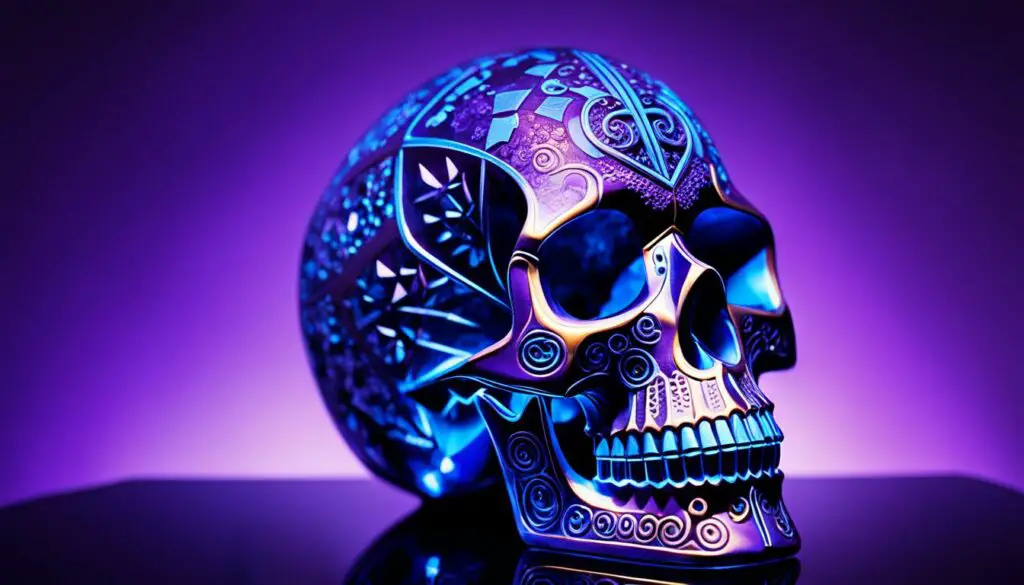
Crystal skulls are fascinating and mysterious objects that have captured the imagination of people around the world. These exquisite hand-carved replicas of human skulls are crafted from clear or milky-colored quartz or crystal. They are believed to hold significant meaning and symbolism, as well as possess extraordinary powers.
Crystal skulls have long been associated with healing and psychic abilities, as well as the power to connect with the spiritual realm. Many believe that these intricate sculptures hold the key to unlocking hidden knowledge and wisdom from the past. Whether used as tools for meditation, divination, or as decorative pieces, crystal skulls have a rich history and profound significance in various cultures.
Ancient, Old, and Modern Crystal Skulls
Crystal skulls can be categorized into three groups based on their age – ancient, old, and modern or contemporary. The classification of a crystal skull often determines its historical context and perceived meaning.
“Crystal skulls can be classified into three groups – ancient, old, and modern or contemporary – based on their age.”
The ancient crystal skulls are believed to be the most enigmatic and carry the weight of ancient civilizations such as the Mayans or Aztecs. These skulls are usually intricately carved and are associated with mystical properties and secrets of the past. They are considered sacred artifacts and symbols of ancient wisdom.
The old crystal skulls, although not as ancient as their counterparts, are still steeped in history and carry the energy of bygone eras. They may have been used for various purposes such as ceremonial rites or as spiritual guides, imparting wisdom to those who encountered them.
The modern or contemporary crystal skulls are relatively new creations, often made in recent times with inspiration drawn from their ancient and old counterparts. These skulls are crafted with intricate details and symbolic carvings, replicating the aesthetics and spiritual significance of the ancient crystal skulls.
The Symbolism and Purposes of Crystal Skulls
The symbolism of crystal skulls is vast and can vary depending on individual beliefs and cultural contexts. These intriguing objects are often seen as powerful tools for spiritual guidance, meditation, and self-healing.
Crystal skulls are believed to possess the ability to amplify and focus energy, making them helpful in channeling and balancing one’s own spiritual energy. They are thought to enhance psychic abilities, deepen connections with higher consciousness, and facilitate spiritual growth and transformation.
Many individuals and spiritual practitioners use crystal skulls as aids in meditation and manifestation. These skulls are thought to hold the collective wisdom of the universe, serving as conduits for divine guidance and insights.
| Crystal Skull Symbolism | Purposes |
|---|---|
| Wisdom and Knowledge | Seeking guidance and spiritual wisdom |
| Protection and Healing | Aiding in physical, emotional, and spiritual healing |
| Connectivity and Oneness | Facilitating connection with higher consciousness and spiritual realms |
| Transformation and Growth | Assisting in personal and spiritual transformation |
“Crystal skulls are believed to hold the collective wisdom of the universe, serving as conduits for divine guidance and insights.”
Crystal skulls have also become popular collectibles among enthusiasts and collectors who appreciate their beauty, craftsmanship, and metaphysical properties. These mesmerizing objects continue to captivate the imagination and inspire awe, inviting individuals to explore the depths of their spiritual journey.
The Mystery of Crystal Skull Origins

The origins of crystal skulls have been the subject of much mystery and controversy. There are conflicting claims and theories surrounding their creation, ranging from ancient civilizations to lost civilizations. However, historians have shed light on the true origins of crystal skulls, debunking the myths and legends that have surrounded them for centuries.
Contrary to popular belief, crystal skulls were not created by ancient civilizations like the Mayans or Aztecs. Instead, they were manufactured in the mid-19th century in Germany and Mexico. This period coincided with a fascination for Mesoamerican culture, which inspired the production of these enigmatic artifacts.
The Crystal Skull Controversy
Due to their mysterious nature and intricate craftsmanship, crystal skulls have been the center of controversy and speculation. Some believed that these skulls possessed mystical powers or were connected to supernatural forces. Others dismissed them as elaborate hoaxes or products of human imagination.
“The crystal skull controversy has fueled heated debates among experts and enthusiasts, raising questions about their authenticity and true purpose.”
While scientific investigations have been inconclusive, the allure and fascination with crystal skulls continue to captivate the human imagination. Whether you believe in their mystical properties or not, there is no denying the cultural significance and intrigue surrounding these enigmatic artifacts.
| Crystal Skull Origins | Crystal Skull Controversy | Crystal Skull Manufacturing |
|---|---|---|
| Mid-19th century | Subject of heated debates | Manufactured in Germany and Mexico |
Despite the controversies, crystal skulls continue to inspire awe and wonder in modern culture. They have been featured in movies, fashion, and art, capturing the imagination of people around the world. Whether you see them as mystical objects or intriguing artifacts, crystal skulls represent a fascinating chapter in the exploration of ancient civilizations and the mysteries of the human mind.
The Popularity of Crystal Skulls
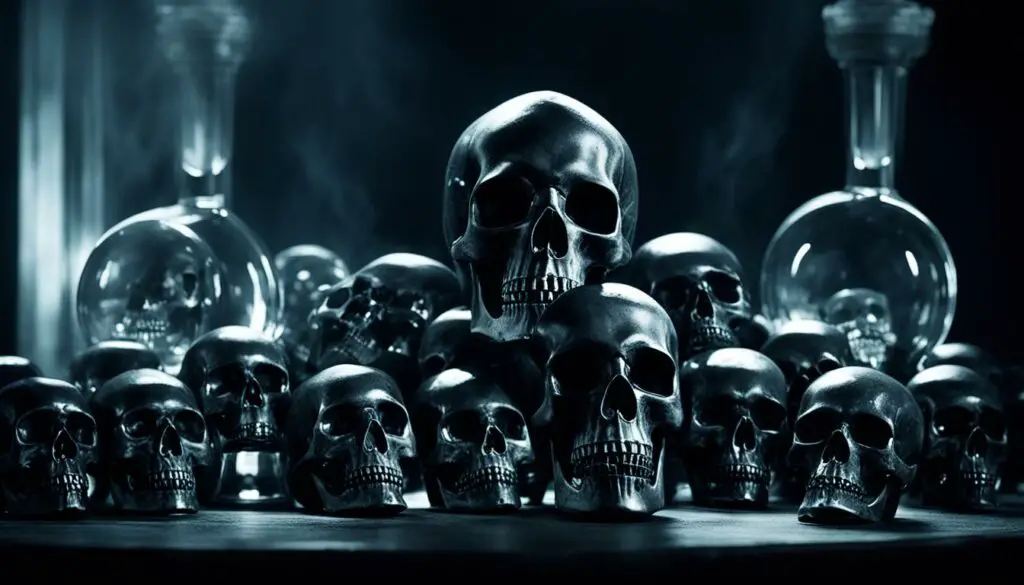
Crystal skulls have become immensely popular in pop culture and have achieved iconic status. These enigmatic objects have made their mark in various forms of entertainment, captivating audiences around the world.
The Influence of Crystal Skulls in Movies
Indiana Jones and the Kingdom of the Crystal Skull is one of the most notable films that prominently features crystal skulls. Released in 2008, this adventure-filled movie follows Indiana Jones as he unravels the mystery surrounding these ancient artifacts.
The Role of Crystal Skulls in Pop Culture
Crystal skulls have resonated with people beyond the big screen. These intriguing objects have captured the imagination of enthusiasts who collect them as decorative pieces or use them for spiritual purposes.
Crystal skulls have also influenced various forms of art, fashion, and jewelry design. Artists and designers incorporate crystal skull motifs into their creations, adding a touch of mystique and symbolism.
A Connection to the Enigmatic and Esoteric
“Crystal skulls are a bridge between the physical and spiritual realms, intriguing individuals who are fascinated by the mysteries of life and beyond. Their allure lies in their mysterious history, believed healing properties, and symbolic meaning. Crystal skulls have become a symbol of the unknown, sparking curiosity and inspiring exploration.”
Crystal skulls continue to have a lasting impact on pop culture, with their popularity showing no signs of waning. These captivating artifacts have become more than just objects; they embody a sense of mystery, spirituality, and intrigue that resonates with people from all walks of life.
| Crystal Skull Popularity | Crystal Skulls in Movies | Crystal Skulls in Pop Culture |
|---|---|---|
| Crystal skulls have gained popularity and become iconic symbols | Indiana Jones and the Kingdom of the Crystal Skull prominently features crystal skulls | Enthusiasts collect crystal skulls, use them as decorative pieces, and incorporate them into art and fashion |
The Symbolism and Meanings of Skulls
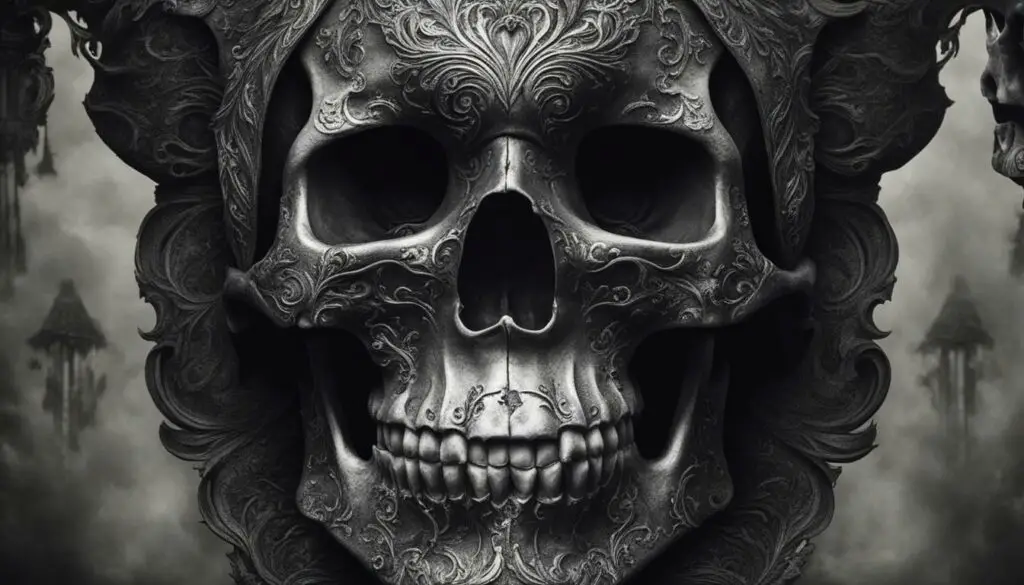
Skulls have long been rich in symbolism and carry various meanings across cultures and subcultures. They can represent different concepts such as bravery, mortality, and nonconformity. In popular culture, skulls are often associated with toughness and free-thinking. Skull motifs have been adopted by many subcultures as a way to express their beliefs and identity.
One well-known design featuring skulls is the skull with crossbones, commonly known as the pirate flag or poison symbol. This combination symbolizes mortality and serves as a warning to others. It has become an iconic image associated with danger and adventure.
Skulls have long been rich in symbolism, representing bravery, mortality, and nonconformity. They are often associated with toughness and free-thinking, making them popular among various subcultures. The skull with crossbones, a warning symbol, serves as a reminder of mortality.
Skull symbolism can also vary depending on the cultural context. For example, in Mexican culture, skulls are often seen during the Day of the Dead celebrations, representing a positive view of death as a part of the natural cycle of life.
The Meanings of Skulls in Different Contexts
Skulls have diverse meanings in different contexts:
- Bravery and courage: Skulls can symbolize fearlessness and strength in the face of adversity. They are often associated with warriors and those who have faced challenges with resilience.
- Mortality and impermanence: Skulls remind us of the fragility and transience of life. They serve as a reminder to live each moment to the fullest.
- Nonconformity and rebellion: Skull motifs are often linked to counterculture movements and a rejection of societal norms. They represent individuality and a refusal to conform.
Skulls continue to be popular motifs in fashion, art, and tattoos, allowing individuals to express their unique beliefs and identity. Whether as symbols of strength, reminders of mortality, or statements of nonconformity, skulls remain a powerful and intriguing aspect of human culture.
| Skull Symbolism | Meanings |
|---|---|
| Bravery and courage | Representing fearlessness and strength |
| Mortality and impermanence | Serving as reminders of life’s fragility |
| Nonconformity and rebellion | Symbolizing individuality and rejection of societal norms |
Skulls as Symbols of Everlasting Life

In many cultures, skulls hold deep symbolism and are associated with the concept of everlasting life. Ancient civilizations believed that indestructible things must be eternal and that death is just a transition to another existence. Consequently, skulls became powerful symbols of immortality, representing the eternal cycle of life.
The belief in the everlasting life symbolism of skulls can be traced back to various ancient cultures. For example, in Aztec mythology, the skull was seen as a symbol of rebirth and was commonly depicted in their art and rituals. The Aztecs believed that the skull was the seat of the soul and that it played a vital role in the journey to the afterlife.
To this day, the symbolism of everlasting life remains potent, resonating with many individuals who seek to express their beliefs and personal journey. Skulls, often worn as jewelry or incorporated into artistic designs, serve as reminders of the impermanence of life and the continuity of the soul beyond this earthly existence.
“The dead are not dead if they still live in the hearts of the living.” – Mexican proverb
Wearing skull jewelry, such as skull rings or pendants, has become a popular fashion trend with a deeper meaning. It allows individuals to embrace their mortality and find solace in the idea that life is a continuous cycle. Skulls are worn as potent symbols of strength, resilience, and the zest for life, serving as powerful reminders to live each day to the fullest.
The Symbolism of Skulls in Ancient Cultures
Skulls have held significant meaning in ancient cultures worldwide. Let’s take a closer look at the role of skulls in some of these civilizations.
| Ancient Culture | Skull Symbolism |
|---|---|
| Egypt | The Egyptians associated skulls with the afterlife and believed that the skull protected the soul during the journey to the underworld. |
| Celtic | In Celtic culture, skulls symbolized the seat of the soul and were believed to hold the wisdom and power of ancestors. |
| Mayan | Mayan civilization regarded skulls as sacred and used them in religious ceremonies to communicate with the spirit world. |
These ancient cultures recognized the inherent symbolism of skulls, linking them to the eternal nature of the human spirit. Today, this concept continues to inspire and fascinate people from all walks of life.
The Superstitions and Taboos Surrounding Skulls
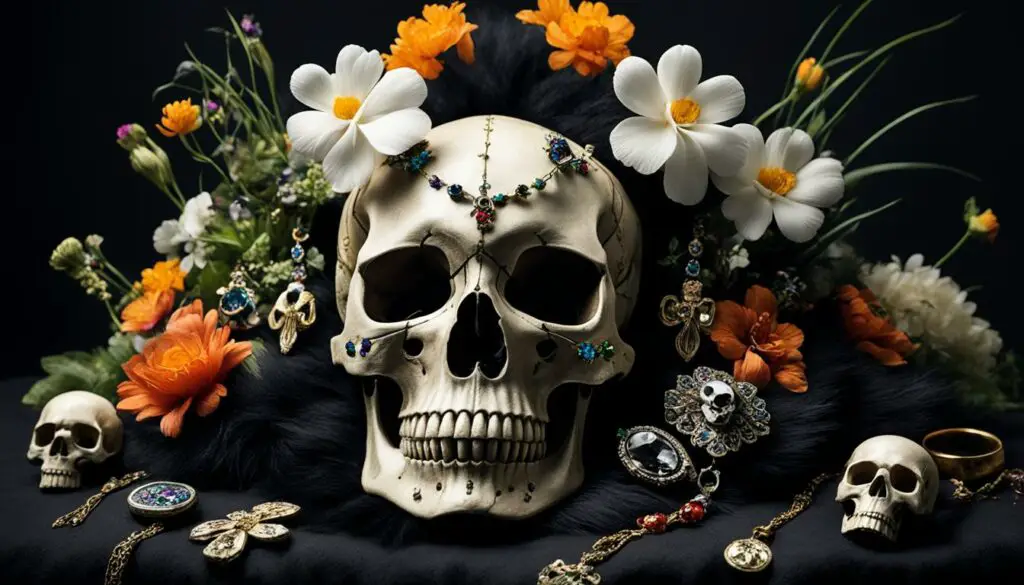
Skulls have always elicited various superstitions and taboos. Some people believe that having a skull in the house or wearing skull imagery can attract bad luck or invite negative influences. However, it’s important to note that these beliefs differ across different cultures and personal perspectives. While some view skulls as harbingers of misfortune, others see them as symbols of protection or spiritual power.
The negative connotations associated with skulls can be traced back to their association with death and mortality. In many cultures, death is seen as a taboo subject, and anything related to it, including skulls, can carry a stigma.
Despite these superstitions, skulls have also been embraced as powerful symbols in various cultural traditions. For example, in Mexico’s Day of the Dead festivities, skulls are intricately decorated and celebrated as a way to honor deceased loved ones. This tradition highlights the belief that death is a natural part of life and should be acknowledged and celebrated rather than feared.
Skull Taboos in Different Cultures
Skull taboos vary greatly across different cultures. In some African cultures, it is believed that touching a skull can bring harm or even death. Similarly, in certain Native American tribes, the skull is considered a powerful and sacred object that should not be touched or tampered with.
“The skull is a portal between the living and the spirit world, and disturbing it can have grave consequences,” says anthropologist Dr. Maria Hernandez.
While these taboos may seem irrational to some, they hold deep cultural and spiritual significance for those who adhere to them. It’s important to respect these beliefs and practices when encountering them in different cultural contexts.
The Misunderstood Symbolism of Skulls
Skulls have a rich symbolic history beyond their association with death. They can represent themes such as bravery, mortality, and nonconformity. In many subcultures, skulls have become an emblem of rebellion and individuality. They are often associated with toughness, resilience, and the rejection of societal norms.
It is essential to recognize that the interpretation of symbols can vary widely. While some may see skulls as negative or ominous, others perceive them as powerful symbols of strength and vitality. The perception of skulls is heavily influenced by cultural, personal, and historical factors.
The Power of Perspective
Ultimately, the superstitions and taboos surrounding skulls are highly subjective. They are deeply rooted in cultural beliefs, personal experiences, and even fear of the unknown. However, it is essential to approach these beliefs with an open mind and respect the diverse perspectives associated with this symbol.
Skulls can be viewed as a reminder of mortality, prompting individuals to reflect on the transient nature of life. Additionally, they can also serve as a powerful symbol of resilience and the affirmation of life’s fragility.
| Superstitions about Skulls | Skull Taboos | Negative Connotations |
|---|---|---|
| Bringing bad luck | Forbidden to touch or tamper with | Stigma associated with death |
| Inviting evil influences | Considered a sacred object | Perceived as ominous or negative |
| Varies across cultures | Rooted in cultural beliefs | Fear of the unknown |
The Craftsmanship and Composition of Crystal Skulls
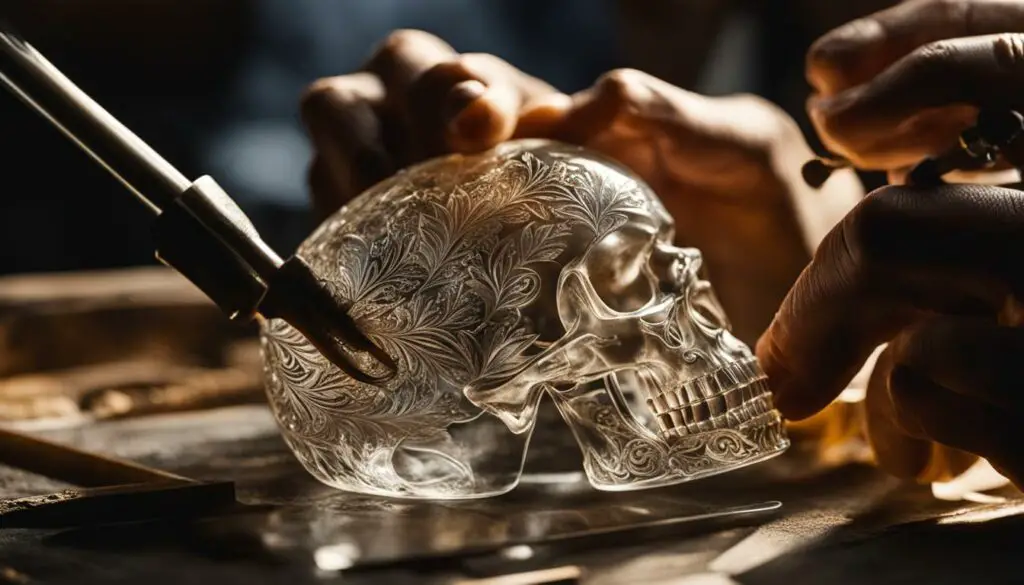
Creating a crystal skull involves meticulous craftsmanship and the careful selection of crystal materials. Skilled artisans carve each skull by hand, paying close attention to intricate details and symbolic significance. The mesmerizing beauty and craftsmanship of crystal skulls make them captivating artifacts.
Crystal skulls can be crafted from various types of crystals, each carrying its own unique properties and healing powers. The choice of crystal used in the creation of a skull can enhance its energy and purpose. The following are some common types of crystals used in crystal skulls:
| Crystal Type | Properties |
|---|---|
| Quartz | Known as the “master healer,” quartz is believed to amplify energy and promote balance and clarity. |
| Amethyst | Associated with spiritual growth and protection, amethyst is said to enhance intuition and facilitate connection with higher realms. |
| Obsidian | A volcanic glass known for its protective properties, obsidian is believed to shield against negativity and aid in grounding and transformation. |
Each crystal used in crystal skull craftsmanship carries its own unique vibrations and properties, enhancing the skull’s spiritual significance. These crystal compositions contribute to the deep connection and resonance that individuals experience when interacting with crystal skulls.
The Powers and Properties of Crystal Skulls

Crystal skulls have captivated the imaginations of people around the world with their mysterious powers and properties. While scientific evidence may be lacking, many individuals believe in the healing and transformative abilities of these intriguing objects.
Crystal skulls are thought to possess a range of metaphysical powers that can positively impact our well-being. Here are some of the key properties associated with crystal skulls:
- Healing: Crystal skulls are believed to promote physical and emotional healing. Many practitioners use them during meditation or energy healing sessions to help balance the body’s energy centers, known as chakras.
- Spiritual Awakening: Crystal skulls are often seen as powerful tools for spiritual growth and awareness. They are thought to enhance psychic abilities and open the mind to higher realms of consciousness.
- Transformation: Crystal skulls are said to aid in personal transformation and self-discovery. They are believed to assist individuals in overcoming obstacles, releasing negative patterns, and embracing positive change.
While the properties attributed to crystal skulls may vary depending on the type of crystal used, such as quartz, amethyst, or obsidian, the overarching belief is that these skulls possess inherent energies that can impact our lives in meaningful ways.
It’s important to note that the powers and properties of crystal skulls exist in the realm of spirituality and personal belief. While some individuals may find solace and peace in the presence of crystal skulls, others may approach them with skepticism.
“Crystal skulls are like keys that unlock the doors to higher realms of healing and consciousness.” – Crystal Healing Expert
Ultimately, whether you choose to explore the powers and properties of crystal skulls is a personal decision. Regardless of their metaphysical significance, these enigmatic objects continue to inspire curiosity and wonder in individuals seeking a deeper connection to themselves and the world around them.
Debunking the Myths and Controversies of Crystal Skulls
Crystal skulls have long been subject to controversies and skepticism, fueling debates about their authenticity and mystical properties. Critics argue that these enigmatic artifacts are nothing more than hoaxes or products of overactive imaginations. However, the allure and fascination surrounding crystal skulls persist, defying scientific investigation.
“Crystal skulls are often dismissed as elaborate fakes or misunderstood relics. But the truth behind these mysterious objects remains elusive.”
Skeptics question the claims of ancient origins associated with crystal skulls. These skeptics propose alternative theories, suggesting that the crystal skulls were fabricated in the mid-19th century in Germany and Mexico. They argue that the skulls were inspired by the prevailing fascination with Mesoamerican culture during that time, rather than being ancient artifacts.
Furthermore, skeptics cast doubt on the alleged mystical properties attributed to crystal skulls. While many believers assert that these skulls possess healing and psychic abilities, scientific investigations have yielded inconclusive results. Skeptics argue that the powers ascribed to crystal skulls are nothing more than a product of subjective interpretation and suggestibility.
Unveiling the Truth
To uncover the truth about crystal skulls, numerous studies have been conducted to analyze their composition, craftsmanship, and age. The results, however, have failed to definitively settle the controversies, leaving room for continued speculation and debate.
- Skeptics believe crystal skulls are modern creations, crafted with skillful precision to resemble ancient artifacts.
- Some argue that the allure of crystal skulls lies in their artistic craftsmanship and the fascination with historical mysteries.
- While proponents of crystal skulls maintain their belief in their mystical properties, skeptics remain unconvinced by the lack of scientific evidence.
The Allure of Crystal Skulls
Despite the skepticism and controversies surrounding crystal skulls, their appeal continues to captivate enthusiasts and collectors alike. Whether one believes in their mystical powers or not, crystal skulls serve as intriguing symbols of history, spirituality, and human imagination.
The Role of Crystal Skulls in Modern Culture
https://www.youtube.com/watch?v=SI936ZD_uTY
Despite the debates and controversies, crystal skulls have made a significant impact on modern culture. These enigmatic objects have transcended their origins to become iconic symbols portrayed in movies, fashion, and art.
Crystal skulls have captured the imagination of many, leading to avid collectors who view them as unique pieces of art or spiritual tools. Whether displayed as decorative pieces or incorporated into meditation and healing practices, crystal skulls continue to inspire awe and wonder.
One of the reasons for the enduring popularity of crystal skulls is their appearance in popular culture. They have been featured prominently in movies like Indiana Jones and the Kingdom of the Crystal Skull, which further fueled interest and intrigue surrounding these ancient artifacts.
“Crystal skulls have an undeniable mystique that captivates audiences and evokes a sense of mystery and adventure.”
Crystal skulls have also become a part of mainstream fashion, with jewelry and accessories featuring skull motifs gaining popularity. These pieces not only showcase style but also serve as an expression of individuality and spirituality.
Furthermore, crystal skulls have found their place in the art world. Artists incorporate them into their creations, exploring themes such as life, death, and the metaphysical. These artworks provide a platform for contemplation and reflection on the deeper meanings associated with crystal skulls.
The Allure of Crystal Skulls
Crystal skulls hold an allure that extends beyond their physical attributes. They possess a sense of mystery and intrigue, inviting individuals to contemplate their origins and potential powers. Some believe that crystal skulls possess healing properties and spiritual energies that can enhance psychic abilities and promote personal transformation.
- Crystal skulls as symbols of wisdom and enlightenment
- The metaphysical properties associated with different types of crystals
- The fascination with ancient civilizations and their enigmatic artifacts
While skepticism exists regarding the supernatural claims surrounding crystal skulls, their cultural significance cannot be denied. These intriguing objects continue to captivate the human imagination, symbolizing both the mysteries of the past and the potential for personal growth.
Conclusion
In conclusion, the belief that skulls bring bad luck is a superstition that varies across different cultures and personal beliefs. While some people associate skulls with negative connotations and taboos, others view them as symbols of protection or spirituality. Crystal skulls, with their intricate craftsmanship and controversial origins, have mesmerized people for centuries. Whether these crystal skulls possess mystical powers or are simply fascinating artifacts is a matter of personal interpretation.
The fascination with skulls and crystal skulls will undoubtedly continue to endure. Their rich symbolism and enigmatic allure capture the imagination of individuals who seek to explore the mysteries of life and death. Whether displayed as decorative pieces, used in spiritual practices, or admired for their exquisite beauty, crystal skulls hold a special place in the hearts of collectors and enthusiasts alike.
In the end, it is up to each individual to determine their own perspective on skulls and crystal skulls. Whether seen as omens of bad luck or as misunderstood icons of history and spirituality, the cultural significance and intrinsic appeal of skulls cannot be denied. As we continue to unravel the secrets surrounding these captivating objects, we remind ourselves of the beauty in embracing diversity and respecting the beliefs and traditions of others.
FAQ
Are skulls bad luck?
The belief that skulls bring bad luck is a superstition with cultural and personal variations. While some people associate skulls with negative connotations, others see them as symbols of protection or spiritual power.
What are some superstitions about skulls?
Some superstitions surrounding skulls include the belief that having a skull in the house or wearing skull imagery can bring bad luck or invite evil influences. However, these beliefs vary across different cultures and personal beliefs.
What are the cultural beliefs about skulls?
Cultural beliefs about skulls differ around the world. In some ancient civilizations, skulls were associated with the concept of everlasting life and believed to represent immortality. However, cultural beliefs about skulls can vary widely.
What is the symbolism of skulls?
Skulls can symbolize bravery, mortality, and nonconformity. In popular culture, they are often associated with toughness and free-thinking. The skull with crossbones, also known as the pirate flag, symbolizes mortality and serves as a warning symbol.
Are there any negative connotations associated with skulls?
While skulls can be seen as symbols of power and bravery, they also carry negative connotations for some individuals. The association of skulls with death and mortality can lead to a perception of darkness or fear.
What are some myths about skulls?
There are various myths surrounding skulls, including the belief that crystal skulls possess mystical powers or are ancient artifacts created by lost civilizations. However, historians have debunked these claims, stating that crystal skulls were manufactured in the mid-19th century.
Are there any taboos surrounding skulls?
Skulls have been associated with superstitions and taboos in certain cultures. Some believe that having a skull in the house or wearing skull imagery can bring bad luck or invite evil influences. However, these beliefs vary and are influenced by personal and cultural beliefs.
How are crystal skulls made?
Crystal skulls are carefully hand-carved by skilled craftsmen using various types of crystal, such as quartz, amethyst, or obsidian. Attention is paid to intricate details and symbolism to create these unique artifacts.
What are the powers and properties of crystal skulls?
Crystal skulls are believed to possess various metaphysical powers and properties, such as promoting healing, balancing energy centers in the body, enhancing psychic abilities, and contributing to spiritual awakening and transformation. These claims lack scientific evidence but are embraced by many individuals for spiritual purposes.
Are crystal skulls controversial?
Crystal skulls have faced skepticism and controversy. Some skeptics argue that they are hoaxes or products of overactive imaginations. Additionally, claims about their ancient origins and mystical properties have been subject to scientific investigations that have been inconclusive.
How do crystal skulls impact modern culture?
Crystal skulls have become iconic symbols portrayed in movies, fashion, and art. Many people collect crystal skulls as a hobby or incorporate them into their spiritual practices, regardless of whether they believe in their supernatural powers or not. They continue to inspire awe and wonder.
